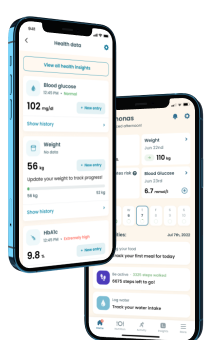Traveling with Diabetes

When you’re traveling with diabetes, you need to do some extra planning to ensure you will be able to continue your diabetes management while you are on the road. Not only do you need to have diabetes supplies on hand; you also need to ensure that you will have access to healthy snacks and meals. Here, learn some tips and reminders to help you with your travel plans when you are living with diabetes.
Tackling Packing
People with diabetes may need to put some extra time and effort into packing for a trip, as forgetting medical supplies can be disastrous. In addition to packing needed diabetes supplies, it is a wise idea to obtain and wear a medical id bracelet, which indicates your diabetes diagnosis, and provides contact information for your doctor in care of emergency.
When traveling with diabetes, be sure to pack all needed supplies, which may include:
- Glucose tablets
- An insulin pump, if you use one
- Insulin pens
- Insulin doses
- Blood glucose testing strips
- Lancets
- Blood glucose monitor
- Syringes
- Any additional medications you take
If you’re traveling with diabetes, it’s always a good idea to bring extra insulin doses. Having a special meal while traveling can elevate blood glucose levels, which may require extra insulin. In addition, having plenty of glucose tablets on hand is essential. If traveling results in delayed meals, low blood glucose levels are a possibility. Blood glucose monitoring may be more important than ever when on vacation, when changes in routine can alter glucose levels. The reality is that you need to be prepared for both highs and lows in blood sugar.
Glucose tablets can be helpful in the case of a blood sugar crash, but you might also want to pack some quick snacks you can rely on in the case of low blood glucose. Cereal bars and hard candy can be useful, and they are easy to throw in a carry on bag.
Dealing with Airline Staff
One important thing to consider when traveling with diabetes, especially if you are traveling abroad or taking an airplane across the United States, is that you need to have all of your medical supplies, including insulin injections and test strips, with you, and you need to be prepared to be searched by airline staff.
If you need to take supplies in a carry on bag, it is critical that you are prepared to comply with TSA guidelines. When you go through airport security, your insulin needs to be clearly labeled. Be ready to inform the TSA staff that you have diabetes and are bringing supplies with you. Show them your marked insulin containers, as well as any pumps and supplies, like test strips, unused syringes, and lancets, that go along with it.
You may be concerned about bringing insulin on the plane, since it is a liquid product. Fortunately, you have rights as a person with diabetes. You are permitted to bring insulin on the plane, even if it is in a container that is larger than the 3.4 ounces typically allowed for other liquids like shampoo and soap.
TSA staff will perform a hand inspection of your diabetes supplies, so it important to set them aside in a separate bag when going through security. The following tips can be helpful for preparing to go through security:
- Clearly mark your insulin.
- Package your supplies in a clear separate bag.
- Let TSA staff know that you have diabetes as soon as it is your turn to go through security.
- Keep in mind that while it is generally safe for people with diabetes to pass through an x ray machine, you can request a hand inspection.
- Do not place insulin in your checked luggage, as temperature and pressure changes can harm it. Store insulin in a cool bag that you carry on the plane with you.
Plan Ahead To Maintain Your Exercise Routine
Your diabetes team has likely helped you to develop a regular exercise routine to assist with keeping blood glucose levels under control. For the best results, it is helpful to continue your exercise plan while on vacation. This doesn’t mean that you have to spend hours working out every day, or travel to a gym to take boot camp classes. It simply means you would benefit from finding a way to work physical activity into your day.
You can plan ahead for physical activity while making an itinerary for your trip. For instance, maybe you plan on touring a local museum or outdoor park during your trip. On the day you complete this tour, you can expect that you will be doing a significant amount of walking. Bring your watch or fitness tracker to log your steps, and the walking you do can count as your exercise for that day.
If you’re traveling to a warm climate, a daily morning walk along the beach or through the local neighborhood can help you to meet your physical activity requirement. Be sure to pack comfortable shoes so you can work this exercise into your day.



Walking can provide adequate exercise, but if you’re someone who enjoys adventure, you might consider exploring a local yoga or Zumba class at your vacation destination. Or, maybe you’re staying at a hotel that has a gym or fitness center. In this case, you may be able to maintain your usual fitness routine while on vacation.
Regardless of what you choose to do, the reality is that you can find a way to get some sort of physical exercise when you’re traveling with diabetes. You may have to alter your usual routine, use some creativity, or try something new, but it is possible to exercise while on vacation. A set of comfortable shoes and some resistance bands can go a long way toward helping you to get some exercise, even if you don’t have access to the gym.
Healthy Eating While Travelling with Diabetes

Beyond packing enough medication for your trip and making a plan for exercise, it is important to keep in mind that it’s essential to maintain a healthy diet when traveling with diabetes. You may treat yourself to a special meal while on vacation, but the truth is that when you live with diabetes, a poor diet can increase the risk of complications.
Eating healthy on vacation doesn’t mean you cannot enjoy meals out or have the occasional splurge. It just means that most of the time, you need to stick to your usual eating plan and make eating choices that keep blood sugar under control.
The American Diabetes Association recommends that people with diabetes follow these guidelines when making food choices:
- Include plenty of fruits and vegetables in your diet.
- Fill half of your plate at each meal with non-starchy vegetables.
- Consume lean meats and plant-based proteins.
- Avoid added sugars and processed foods.
The guidelines above are not particularly restrictive. You can likely still enjoy your favorite restaurants while traveling with diabetes; you will just need to plan ahead so you can ensure you’ll be able to make appropriate choices for disease control. It’s not a bad idea to search restaurants in the area where you’ll be traveling, and view menus to make some decisions about where to eat, and what you’ll order when you get there.
Some good options for restaurant meals that can help you to keep blood sugar levels under control include:
- Grilled chicken dishes with a side of vegetables.
- Salad topped with a lean protein source, like eggs or grilled meat.
- Fajitas filled with chicken and vegetables.
- Turkey sandwiches on whole grain bread, with a side of fruit.
- Omelets loaded with veggies.
- Salmon with a side of vegetables.
- Stir-fry dishes with meat and vegetables.
- Rice and quinoa dishes topped with beans and vegetables.
Beyond these specific dishes, it’s helpful to limit heavily processed fast food dishes, and avoid foods that are fried or high in fat, such as French fries, donuts, and creamy dishes like chicken alfredo or cheesy soups. It’s also a good idea to keep healthy snacks, such as apples, cheese sticks, or a handful of almonds on hand, so you have something to keep you satiated and keep blood sugar levels within a healthy range between meals. Having healthy snacks available also reduces the temptation to indulge in processed snacks like cookies or chips.
Finally, plan to keep meal times as close to possible as what you’re accustomed to when at home. Having regularly timed meals can keep your blood glucose levels within a normal range. When you’re eating at a restaurant, it’s also important to monitor your blood sugar. Even if you research nutrition facts for the food you’re ordering, it is impossible to know exact portion sizes, so there is a chance you may need more insulin than planned for.
Prepare for the Unexpected
Most of the time, you can enjoy a trip with diabetes, without any major complications or setbacks. That being said, it’s always beneficial to be prepared in case of emergency. When you’re making travel plans and you have diabetes, it may be helpful to consider the following tips:
- Purchase travel insurance, in case you have unexpected health issues, such as a hospitalization, that requires you to cancel your trip.
- Consider changing your trip to another time if you have had a recent prescription change and aren’t sure how your body will respond.
- Keep contact details for your doctor on hand, in case you need to reach out during your trip.
- Write down what you will need, in terms of medical care, in case of an emergency. This allows emergency personnel, or the people traveling with you, to help should the need arise.
- Consider whether there will be a language barrier. If you’re traveling to other countries, it may be helpful to develop a basic understanding of the local language, or at least learn a few key phrases, so you can communicate in case of emergency.
- Explore whether there will be a change in time zone. If you’re crossing time zones, you may need to make changes to the timing of your insulin doses or meals.
- Make plans for staying safe if you’re traveling to an area experiencing hot weather, which can lead to excessive sweating and dehydration. If you become dehydrated, your blood glucose levels may rise, which may require a change to your insulin dose.
The Bottom Line on Traveling with Diabetes
If you’re planning a trip and you have diabetes, you may need to put forth some extra time and effort to make sure things go well. You can certainly enjoy a vacation or weekend trip with diabetes, so long as you ensure that you bring enough supplies for your trip (medications, test strips, glucose monitors, syringes, etc.) and plan ahead to incorporate exercise and healthy eating into your travel plans.
Take a quiz and get your diabetes-management plan today!









